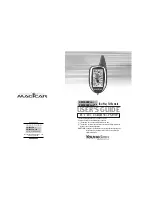
7.3 Jumper Settings
Jumpers
Description
JP1
VPWI selection, default VPWI = 2.5 V
JP2
AVIN selection, default AVIN = PVIN
J2
Default Closed: switching frequency is controlled by R20 (300 kHz default)
When Open: switching frequency is synchronized to clock source connected to SYNC terminal
J3
Default OPEN
Should only be connected when AVIN ≤ 5 V. When AVIN ≤ 5 V, connecting J3 can improve efficiency.
Caution: if AVIN > 5.5 V, connecting J3 could damage the LM10500 device.
J7
Default OPEN
Should only be connected when no voltage supply is connected to PVIN and AVIN. Intended for easy
demonstration of the board by powering PVIN and AVIN by VBAT = 3.6 V.
Caution: if PVIN is higher than 5.5 V, connecting J7 could damage the USB2PWI board. VBAT can not support
large load current.
P1
PWI version and address selection. Note that the LM10500 supports PWI1, PWI2-0, PWI2-1, PWI2-2, and
PWI2-3. The USB2PWI board supports PWI1 and PWI2-0.
8 Operation Guide
8.1 Standalone Operation
The LM10500 evaluation board can operate standalone without PWI interface connected. It is a full-featured
high performance 5-A synchronous buck regulator optimized for solution size, flexibility, and high conversion
efficiency. It also features monolithic integration of the following:
• High-side and low-side power MOSFETs
• Resistor programmable switching frequency
• Frequency synchronization
• Internal soft start
• Precision enable
• Power-good (PWROK) indicator
• Input undervoltage lockout
• Overvoltage protection
• Overcurrent protection
• Thermal shutdown
8.2 PWI Communication Using USB2PWI Board
The unique feature of the LM10500 is close-loop adaptive voltage scaling (AVS) capability. The LM10500
operates cooperatively with PowerWise AVS-compatible ASICs, SoCs, and processors to optimize supply
voltages adaptively over process and temperature variations. To simplify the evaluation of the AVS functions
in the LM10500, the evaluation board is designed to operate with the USB2PWI interface board (included in the
evaluation kit). With the USB2PWI board, PWI registers and LM10500 operating states can be controlled by a
PC through a simple register-based graphical user interface (GUI). Connect the LM10500 evaluation board on
top of the USB2PWI board by J4, J5 and J6, as shown in
, then connect the USB2PWI board to a PC
with a 5-pin mini USB cable (included in the evaluation kit).
Figure 8-1. Connecting the LM10500 Evaluation Board to the USB2PWI Interface Board
Connection Guide
6
LM10500 Step-Down Converter Evaluation Module User's Guide
SNVA453B – AUGUST 2011 – REVISED JANUARY 2022
Copyright © 2022 Texas Instruments Incorporated







































